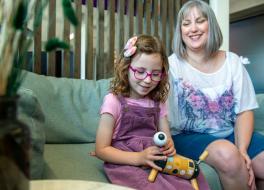Find out how you as a parent or guardian can help your child who stammers.
It can feel scary at first if your child starts stammering. You might worry if you're doing the right thing to help them.
It's OK. There are lots of things you can do. See our tips below. We also tell you how to get extra help, and about our parent support groups and workshops. If you still have questions or concerns, chat to us. Phone our free helpline on 0808 802 0002 or start a webchat.
Is my child stammering and why?
Is your child speaking differently but you're not sure if it's a stammer?
A child who stammers might do one or more of these things:
- Repeat sounds or words. For example "M-m-m-mummy".
- Stretch or prolong sounds. For example "Can you read me a ssssssstory?".
- Have a silent block where a sound gets stuck. For example "---------Can I have…". A block could last for a few seconds or it could last longer.
These can happen at any point in a sentence.

They might also:
- appear tense in their mouth, face or body
- change their breathing pattern or feel out of breath
- close their eyes or look away
- use other parts of their body to help get a word out or release tension. For example they might jerk their head, tap their fingers or stamp their feet
- say "um" or "er" or repeat a word they've already said to help launch into words they find more difficult to say.
Is it my fault?
Parents sometimes ask us if they are to blame when their child start stammering. The answer is categorically NO! Watch our video below and read What Causes Stammering? There we explain what we know about why children start stammering.
Does your child speak more than one language? If you're worried about it, see Stammering & Bilingual Children.
Talking with a child who stammers
How you and other people respond to your child's stammer is important. It will shape your child’s perception of themselves.
It's OK to feel worried at first, but if you seem anxious, it may make your child feel worried too. Try to stay neutral even if that's not how you're feeling.
Here are some things you can do. They may not seem like big changes but they can make a huge difference. They can reduce the pressure your child may feel when talking:
- Slow down your own rate of speech and use longer pauses. This keeps the conversation calm and relaxed.
- Don't tell a child who stammers to slow down or take a deep breath. Instead, tell them that there is plenty of time and you are happy to wait for them.
- Try to have regular one-to-one time with your child, even if it's just for five minutes. Find time when they aren't competing with tasks or other family members for attention.
- Ask one question at a time and give them plenty of time to answer. Show them it's okay to pause and take some time between hearing and answering questions.
- Use short, simple sentences.
- Don't interrupt or try to finish their sentences for them. While it may feel helpful, if you get it wrong they have to start all over again.
- Keep natural eye-contact.
- Listen to what your child is saying, not how they say it.
- If it feels right for you and your child, it's okay to acknowledge when they are finding it more difficult to talk. Reassure and encourage them. For example, you could say, "Learning to talk is hard — lots of people get stuck on their words and that's OK. You're doing really well".
- Make sure everyone in the conversation gets a turn to speak.
The most important lesson I learnt was to slow down my own speech.
Watch our video below:
Video: How you can help a child who stammers
Read our article on Nurturing resilience in children who stammer. It gives practical tips on helping a child to think and feel better about stammering.
Changing our language
When talking with your child or with others about stammering, try not to describe it as 'good' and 'bad'. For example, "Your speech has been really good today" or "Her stammering's been really bad this week".
Language like this can make a child feel that the way they're talking is wrong. Or that they're being bad or are failing in some way when they stammer. This can chip away at their confidence. It could make them anxious about speaking or make other anxieties worse.
Instead, describe changes in stammering as 'more' or 'less'. For example, "She's been stammering more this week", or "He's been stammering less today". This gives you a way to talk about changes in your child's stammer without any judgement.
Watch more videos below:
Talking to a child who stammers
Becoming more comfortable with your child's stammering
One-to-one time with your child who stammers
How to talk about stammering
We've got more on our Videos For Parents page. You can also read written transcriptions of the videos.
Supporting yourself
Watch the video 'My Stammering Tap'. It explores the concerns you might have when your child starts stammering. It was made by Humber Teaching NHS Foundation Trust, My Pocket Films and Action for Stammering Children.
Read a great article from Jessica, parent of a 4-year-old boy: 'Supporting myself as the parent of a child who stammers'.
Our online groups & workshops
- Come to our 'Parent 2 Parent online support groups. Here you can meet and chat to other parents, and share experiences and tips.
- We sometimes run online Workshops for parents.
- Plus, we've got a Minecraft Club, where children aged 7 to 14 can get together online and play the game Minecraft.
Getting extra support through therapy
Have you tried the strategies above and you're still worried? Would you like some extra help?
You could get an appointment with a speech & language therapist or find a stammering course. See Children's Stammering Therapy & Courses for details.
Is your child having therapy at the moment but you don't think it's having an effect? See What To Do If Child Therapy Isn't Working Out.
The 'Penguin' app
There's an app for parents called 'Penguin: Stammering Support' which might help. It's a 10-day programme if your child has started stammering, created by BeneTalk.
Each day there's a short video with a task to help reflect on your situation. It then helps set up strategies to support you and your family. This app is also used by quite a few NHS Speech & Language Therapists.
School
See our Stammering At School page for details on getting support for your child in the classroom. For example, it has information about how to get extra time in oral or spoken exams if your child stammers.
If you have any questions about stammering and school, get in touch with us. Call our helpline for free on 0808 802 0002, start a webchat or email help@stamma.org
Books for parents & children
See a list of Books For Parents & Children on the market. It includes self-help books for parents and stories to encourage and inspire young people.
If you have a teenager who stammers
Adolescence can be a difficult time for young people who stammer.
They may want to be more independent. They might feel extra pressure at school or with exams and start to worry more about friendships. Anxious thoughts about stammering may make them avoid situations they're worried about.
Teenagers who stammer know that they sound different to their peers. They may well have read information about stammering on the internet. Some may also have been to speech & language therapy when they were younger. Or they might be having therapy now.
It can be hard for teenagers to talk about topics that worry them. Be patient and create a safe space for them to talk. Let them know it is OK to share their worries and thoughts with you. Talk openly with them about stammering and let them know that they are not alone.
Reinforce that stammering is not a limitation, nor is it something to be ashamed of. Show them our page of Influential People Who Stammer.
Our Your Voice section has lots of articles by people who stammer getting on in their careers. Watch videos from ‘Stambassadors', successful people talking about their stammers.
Download our 'Reasonable adjustments for pupils who stammer' guide below. It explains how they or you can ask for changes at their school/college or university to make things easier for them.
We've also got a Minecraft Club, where children aged 7 to 14 can get together online and play the game Minecraft.
Parent & teen support group
Don't forget to get support for yourself if you need it. At STAMMA we run a parent-led support group for parents of secondary school children who stammer.
Other sources of support
Here are some other ways you can get support:
Download one of our information leaflets below. Or you can order them from our Shop for free.
UK Peer to Peer Support Group for Parents of Children who Stammer. A Facebook group for parents to support each other and share experiences, thoughts and ideas. It's a closed group so only members can post and respond.
The STAMMA 'Space For Stammering' Facebook group. This provides a space to share experiences, ask for advice and talk openly about stammering. Lots of parents are members. The group is moderated by STAMMA staff and volunteers.
Action for Stammering Children. An informative website on stammering with a focus on children and young people.
More information
Share your experiences
You can help other parents of children who stammer in these ways:
- Join one of our Parent2Parent online support group meetings.
- Write a Your Voice article. Share your experiences to encourage or help other parents.
- See if there's a research project you can get involved with. There are often questionnaires or online interviews where parents can share their experiences.
What next?
- Become A STAMMA Member for free and join the community. We'll keep you updated with new workshops and parent group meetings.
- Get involved with the STAMMA community. Find an event, fundraise, share your story, volunteer, take part in research and more.
Donate & make a difference
Creating this page was only possible thanks to your kind donations.
Please consider making a donation to STAMMA: click here. You'll be helping us to:
- keep our support services running for people who stammer and worried parents
- put on workshops and support groups
- stage events to bring people together
- create guides for teachers and employers
- create our award-winning campaigns for change.
Thank you.
Our information
Find out How We Produce Our Information.
What did you think of this page? Give us your feedback, we'd love to hear from you.




































